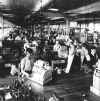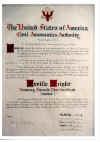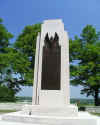|



Meanwhile:
How about a
little music?
We have a selection of tunes that were
popular during the first days of aviation, performed by Sue Keller, courtesy the
Ragtime Press:
Want to ask a question? Tell
us something? Arrange a showing of one of our airplanes? Ping:
mailto:[email protected]
| |
"The
great bird will make its first flight,
filling the whole world with amazement,
filling all records with its fame,
and bringing eternal glory to its birthplace."
-- LEONARDO DA VINCI,
anticipating the invention of mechanical flight in 1505.
|
Click on a
photo to enlarge it. |
 n
1909, Wilbur Wright gave a talk after completing a flight past Manhattan
Island, in full view of millions of people. When asked what advice he had
for the young people who admired him, he said,
"If I were giving a young man advice in how he might succeed in life,
I would say to him, pick out a good mother and father and begin life in
Dayton, Ohio." n
1909, Wilbur Wright gave a talk after completing a flight past Manhattan
Island, in full view of millions of people. When asked what advice he had
for the young people who admired him, he said,
"If I were giving a young man advice in how he might succeed in life,
I would say to him, pick out a good mother and father and begin life in
Dayton, Ohio."Wilbur himself was born in Millville, Indiana. Orville was born in
Dayton and spent the first 6 years of his life in the house of Hawthorne
Street. The Wright family moved to Iowa when Orville was 6 and Wilbur was
10, then back to Indiana, then both Wilbur and Orville finally landed
back in Dayton in 1884 when they were in their teens. While they had lived
in several different locations, they spent the largest part of their youth
in Dayton, Ohio and they considered it home.
After their first powered flights on December 17, 1903, they began to
refine their powered aircraft at Huffman Prairie, just outside of Dayton.
They built the first military aircraft here and the airplanes that they
demonstrated overseas in 1908 and 1909. When Dayton, Ohio welcomed them
home in 1909 with a city-wide celebration, Orville and Wilbur stood in a
reception line the
hall of the Dayton YMCA for as long as they possibly could, shaking hands with each and
every Dayton citizen who came to see them. The line, it's reported,
stretched for many city blocks.
And when New York financiers back the Wright Company for one million
dollars to build airplanes and asked the Wright brothers to build the
factory in New York where the investors could keep an eye on it, Wilbur
and Orville balked. They insisted it be located in their home town so the people of Dayton
would benefit from the new jobs.
With all this activity in Dayton, Ohio, it's not surprising that the
city is full of landmarks where the Wright brothers lived, worked and flew.
Furthermore, Dayton is the site of a unique national historic park and one
of the most precious artifacts in all of aviation. In the 1990s, some Daytonians, concerned that their aviation heritage
was under appreciated and that the world would be looking to Dayton during
the Centennial of Flight in 2003, began a campaign to get the nation to
recognize the achievements of the Wrights in Dayton.
Aviation Trail, Inc. was successful in creating the Dayton
Aviation Heritage National Historic Park, including one of the
original Wright bicycle shops, the home of Paul Laurence Dunbar, the 1905
Wright Flyer 3, and Huffman Prairie. And work continues to restore additional
pioneer aviation landmarks and create interpretive displays so visitors
can better appreciate Dayton's unique heritage.
Below, we have listed just a few of the more important locations that have to do with the Wright
brothers or pioneer aviation.
|
Dayton during the days
when the Wright brothers lived and worked there:

Downtown Dayton in 1889.

Main Street in 1910.

Hawthorne Street, where the Wright family lived.

National Cash Register, the largest employer in
Dayton.

Steele High School, where Katherine Wright taught.

The Interurban, and Electric railway that the Wright
brothers rode to Huffman Prairie.

Crowds meeting the Wright brothers at the Dayton
train station in 1909.

The Wright Homecoming Parade in 1909.
|
| 1905 Wright Flyer 3
-- The world's first practical airplane -- what author/historian
Charles Gibbs-Smith called aviation's most precious artifact -- is enshrined in Wright Hall at Carillon
Park. The park is really a campus of historic buildings that house
artifacts from Dayton, Ohio's unique history. There is a special emphasis
on the inventions and innovations that have come out of Dayton,
especially those related to transportation. There is a complex of three
connected buildings dedicated to the Wright brothers, including Wright
Hall (which houses the original 1905 Wright Flyer 3), a replica of the
Wright Cycle Shop at 1127 West Third Street (where the Wrights built their
gliders and Flyers), and the new Barry Aviation
Center. There are new displays now being installed in all three buildings that
will tell the story of the Wright brothers. These should be finished later
in 2002. Click
for MAP!
If you'd like to see the 1905 Wright Flyer 3 up close and in detail, the museum
staff at Carillon Park kindly let us photograph it from every angle. Click
HERE for the
photos.
|



The restoration of the 1905 Wright Flyer 3 was Orville Wright's last
major project before he died in 1948.
|
| Engineers Club -- The
Engineer's Club of Dayton, Ohio is a unique organization of professional
men and women who share Dayton's proud heritage of invention and
innovation. There are more patents per capita in Dayton, Ohio than any
other place on the planet. Orville Wright was one of the founding members
and a past president of the Club. He bequeathed a unique artifact to the
club -- the 1904 "test engine." It was precisely the same as the
engines in the Flyer 1, 2, and 3, but this particular engine never flew.
It was used as a test bed for ideas that the Wrights later incorporated in
the commercial aircraft engines. The Club also has Orville Wright's pilot
license (Number 1, of course) and the only known recording of his voice. Click
for MAP! |

The 1904 Wright "test engine" now resides
in the Engineers Club.

Orville's Pilot's License, issued by the Civil
Aviation Authority.
|
| Flyover
-- "Flyover" is an abstract sculpture
by David Black depicting the first powered flight of the Wright brothers. The steel tubes
are 120 feet long (the length of the first flight) and they trace what it
known of Orville's path through the sky on December 17, 1903. It's also somewhat controversial
-- a minor skirmish in the struggle between representational and abstract
art that has been going on ever since the abstract school came into its
own about the same time the Wright brothers invented the airplane. No
matter -- the controversy adds interest and the need to explain this
abstraction to visitors simply helps educate folks about the Wright
brothers. It has various
nicknames in the community that can be used with affection or disparity,
depending on your tastes in art -- the "Dinosaur Tail" and the
"Venetian Blinds" are two favorites. Click
for MAP! |



Several views of Flyover.
|
| Flyer 3 --
Daytonians and visitors to Dayton who prefer representational art were
finally served in 2001 when the City of Dayton unveiled a life size statue
of Wilbur, Orville, and the 1905 Wright Flyer 3. The 1905 is in flight,
Wilbur is the pilot, and Orville is running along just ahead of the plane,
cheering. Inside the motor housing an electric motor turns the propellers
and causes the rudder and elevator to move. The statue rests next to the
Engineers Club and is part of Van Cleve Park, a shrine to Dayton inventors
-- of which there are many. The woven surface of the wings, in case you're
wondering, is to spoil ay lift that might develop from a strong wind
blowing over them. Dayton doesn't want this particular airplane to fly --
we were much too long in getting it. Click
for MAP! |

The Flyer 3, a full-size statue of the
world's first practical airplane in steel and aluminum.

Close-up of the Flyer 3, showing Wilbur in
the cockpit.
|
| Hawthorne Hill --
In 1911, the Wrights began to build a mansion in Oakwood, a suburb of
Dayton, Ohio. It was finished in 1914, and Orville, his sister Katharine,
and their father Milton moved in. Wilbur, unfortunately, had died in the interim.
After Orville's death in 1948, the National Cash Register Company bought
the mansion and used it for a guest house, although the kept two rooms,
including Orville's study, just as they were when the last inventor of the
airplane passed away. It remains in their hands and
is only open to the public on special occasions. Click
for MAP! |


Hawthorne Hill is symmetrical -- it looks precisely
the same from the back and the front -- or from side to side.
|
| Huffman Prairie --
Of all the places that the Wright brothers worked, the Prairie probably
holds the most aviation history. This is where the Wright brothers refined
their primitive Flyer into a practical aircraft and developed the skills
necessary to fly it. And of all the places in Dayton that are important to
the Wright story, Huffman Prairie has changed the least -- in fact it is
just the way it was 100 years ago. This is surprising when you
consider that it is bounded on all sides by one of the largest and most
active military bases in America, Wright-Patterson Air Force Base. Out of
respect, it was left undeveloped except for a replica of the 1904 hangar
and launching derrick. There is a huge runway just a few hundred yards
north, and you can stand on the Prairie and watch US Air Force pilots
practice landing and taking off in huge bombers and cargo aircraft. The
pattern they fly takes them in a wide circle around Huffman Prairie. It
gives you goosebumps to stand there in the tall grass and think that this
is exactly what you would have seen in 1905 -- an airplane going round and
round the Prairie. Click
for MAP! |

A replica of the 1904-05 hangar at Huffman Prairie.

Wildflowers and tall grasses cover much of Prairie.

A B-52 shoots touch-and-go's (landings and
take-offs) just a few thousand yards from the old Wright hangar.
|
| United States Air Force
Museum -- The USAF Museum is the most visited
museum in all of Ohio, and for good reason. The museum tells the story of
the most exciting part of aviation, military aviation -- the really
fast stuff. It starts at the very beginning with a replica the 1909
Wright Military Flyer, the United States military's first
airplane. (It was assigned to the U.S. Army Signal Corps and flew and
astonishing 42 miles per hour.) There is also
an original 1911 Wright Model B, still in the same flying condition
as when it was retired -- modified with a more powerful engine and
ailerons. Both airplanes are part of a large and exciting display on
pioneer military aviation that includes a Curtiss Model D, a Bleriot XI, and other primitive birds.
Click
for MAP! |

The USAF Museum recounts the entire history of U.S.
military aviation, from the 1909 Wright Military Flyer...

...to the YF-22, or Joint Strike Fighter.
|
| Woodland Cemetery -- Woodland
holds the graves of the Wright family, including Wilbur and Orville. The
gravestones are simple-but-elegant affairs, as befits the personalities
and the proclivities of
the Wrights themselves. There is a single large stone that simply says
"Wright," then smaller stones very low to the ground that mark
the resting places of the members of the family. They are buried high on a hill, overlooking the
city of Dayton. Click
for MAP! |

The Wright family plot in Woodland Cemetery.

The small, low headstones marking the graves of
Wilbur, Katharine, and Orville.
|
| Wright B Flyer, Inc.
-- The Wright B Flyer
hangar is home to two flying replicas. The "Iron
B," as its known affectionately among Dayton pilots, is as standoff replica
of the 1910-1914 Wright Model B. It's made from steel and aluminum; sports
a powerful, reliable engine, high speed propellers, and modern controls --
and it is
certified for exhibition flights. In the air, it looks and flies like an
old-time Model B. The second aircraft is an historically accurate and
beautifully crafted replica
of the Model B, built by Tom and Nancy Valentine. This faithful
stick-and-cloth reproduction flew for the movie, The Winds of Kitty
Hawk. The Wright B folks plan to keep the Valentine B out at Huffman
Prairie during 2003. Click
for MAP! |

The "Iron B" flying Wright Model B
standoff replica...

... and a historically accurate flying replica of a
Model B by Tom and Nancy Valentine.
|
| Wright Bench --
Perhaps one of the most elegant and eloquent memorials to the Wright
brothers in Dayton is also the simplest. At several locations throughout
the city, such as the Engineers Club or Woodland Cemetery, you will come
upon a Wright Bench -- a bronze bench with two derbies side by side. |

Simple but eloquent -- like the brothers themselves. |
| Wright Company --
Amazing as it seems, the original buildings built by the Wright brothers
in 1910 to manufacture airplanes are still standing and they are in
relatively good shape. Unfortunately, they aren't open to the public. They are
still in use as a manufacturing facility, part of the Delphi plant, a maker of automobile parts. (Until recently,
Delphi was part of
General Motors.) The Delphi management is aware of and appreciates this valuable
heritage. They carefully preserve the buildings,
and hope to do something with them for 2003 to share this unique
structure with the public. Click
for MAP! |

The Wright Company building as they stand in the
middle of the Delphi plant.

Orville's old office in Building 1.
|
| Wright Cycle Company
-- The Wright brothers built bicycles at 22 South Williams Street in 1895
and 1896, just as they began to dream of flight. The building was
forgotten, then rediscovered by Fred Fisk and Marvin Todd (authors of The
Wright Brothers, from Bicycles to Airplanes). The shop was restored to
its original condition, then incorporated as part of the Dayton Aviation
Heritage National Historic Park. You can visit it most days and be
entertained by the rangers, who give a lively and exciting talk on the
Wright brothers. If you do, think about this: The floors are untouched;
they are exactly as they were on 1896. You are standing on the very same
floorboards were Wilbur and Orville once stood. Click
for MAP! |

The restored Wright Cycle Company at 22 South
Williams Street, just of West Third in Dayton, Ohio.

Bikes from the Wright era on display in the shop.
|
| Wright Memorial --
This is the sister memorial to the spire that stands atop Big Kill Devil
Hill near Kitty Hawk, North Carolina. If you're going to memorialize the
Wrights, there are really two important places on the earth that you must
mark -- the sand dunes near Kitty Hawk and the rolling grass at Huffman
Prairie. The Wrights conducted their initial aeronautical experiments at
Kitty Hawk because they needed the wind to fly their gliders. Then they
developed their powered Flyer into a practical aircraft and learned the
skills necessary to fly it at Huffman Prairie. Just as the North Carolina
monument stands above the dunes at Kitty Hawk, the Wright Memorial is
perched on a hill overlooking Huffman
Prairie. Presently, the National Park Service is building a reception
center there to help tell the story of the Wright brothers to visitors. Click
for MAP! |

The Wright Memorial atop Wright Hill.

The view of Huffman Prairie from the Wright
Memorial.

This plaque at the Memorial remembers all the pilots
who learned to fly at Huffman Prairie.
|
Back to the top
|

